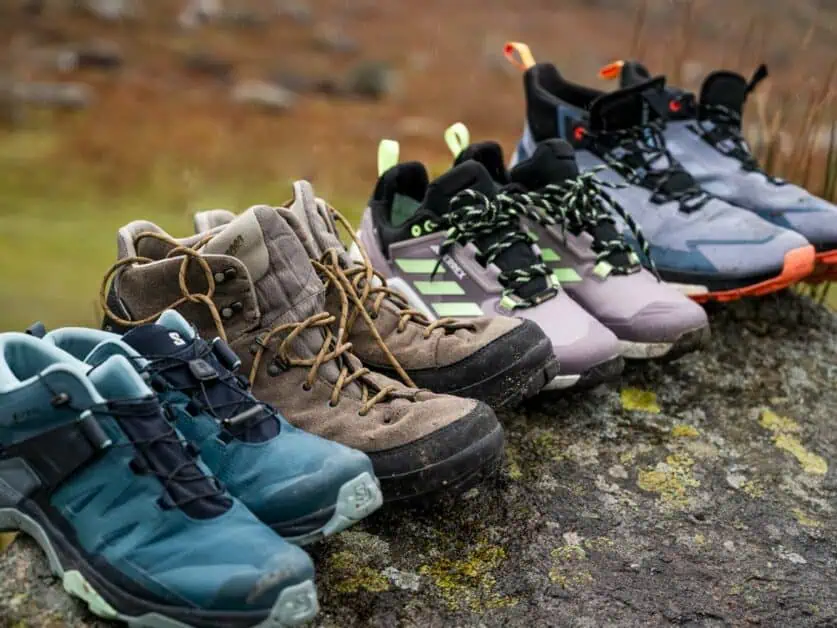
What kind of hiking shoes do you need for your particular type of hiking? Aren’t they all the same anyway? You’d be surprised to learn that there are so many differences between the different hiking shoes on the market. With this in mind, it is important to make your decision based on various factors. Where you plan to hike – are most of the surfaces you’ll be hiking on slippery with heavy tree roots or rocks? Will you be backpacking lightweight and want to move quickly over the trail? What kind of weather conditions will you experience? Do you have any previous injuries that are of concern?
Below, we take a look at the different things to consider when buying a pair of hiking shoes, to help you make the best decision for your needs out on the trail and to find a pair you’re really happy with.
Editor’s note: This article is part of our guide to the best hiking shoes, be sure to check out the rest of this guide for our top buying tips:
Table of Contents
ToggleTypes of Hiking Shoes
There are so many different types and styles of hiking shoes on the market that it can feel a little overwhelming to find the right pair – or know if you’ve made an investment in a pair that are right for your time outdoors. Whilst manufacturers information is there to be helpful, it often doesn’t contain the information you need to make a confident decision, and it’s really more about their practical application.
Budget Hiking Shoes
There are a wide variety of hiking shoes that fall into the budget end of the market. These are great if you’re newer to hiking and aren’t sure of the kind of hiking you plan to do just yet. They’re also great if you’re on a budget (as the name might suggest). They often get a bad reputation, in favor of more expensive options, but this shouldn’t be the case. They often pack well above their weight. For example, the Columbia Facet 75 Outdry and the Regatta Vendeavour Pro are options that provide incredible comfort and durability for a fraction of the cost of many of their competitors.
What you may need to expect is that budget hiking shoes won’t be the lightest or often most breathable on the market – one of the ways that many manufacturers can cut down on price is by reducing state of the art material usage. They can also have slightly less rigid or chunky sole patterns which can hinder long term durability. Though, depending on how much you wear your hiking shoes, it really is worth keeping in mind that no shoe is built to last forever!
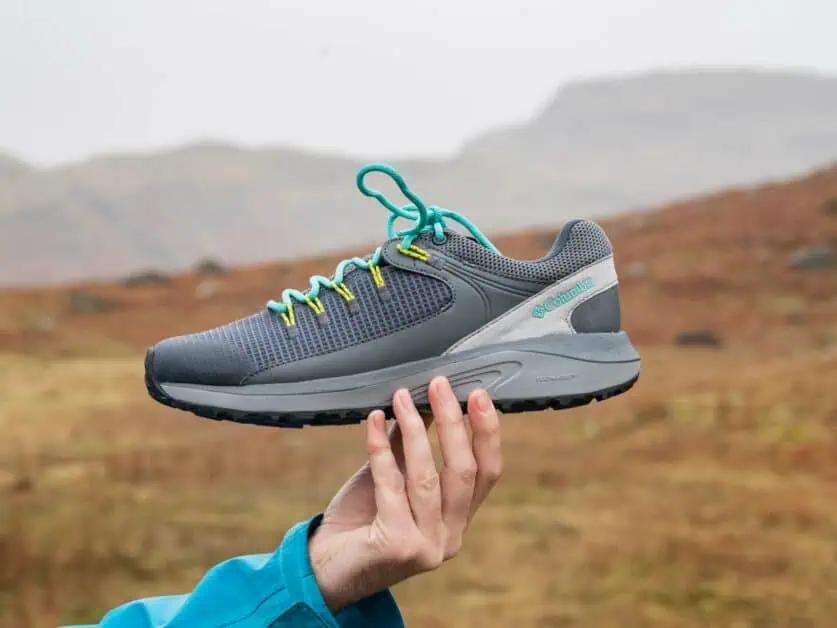
Ultralight Hiking Shoes
Ultralight hiking shoes have made a place for themselves in the outdoor footwear market mainly intended for those wanting to move fast and light. These kinds of hiking shoes are often favored by fastpacking backpackers. They often make use of cutting edge materials, similar to that of top end backpacking tents to offer reductions in weight. You may also find that these will not offer the greatest level of waterproofing either. They typically don’t do as well on paved surfaces as they do on softer trails and can wear down faster than chunkier tread hiking shoes. The Altra Lone Peak 7, which we’ve reviewed is a good example of an ultralight hiking shoe.
Trail Running Shoes
Capturing the hybrid between a traditional running shoe and a hiking shoe, the trail running shoe offers the best of both worlds and depending on the kind of hiking you intend to do, may be right for you – but they are not the best in all circumstances. If you’re planning to do a lot of fastpacking or fast hiking, then a trail running shoe is designed with speed in mind. You’ll often find lightweight materials used and an ergonomic design in both the heel and toe to provide added bounce. If you know you’ll be spending time off trail or in rocky terrain, they may not be the best approach and are best suited to well-maintained, well-defined trails that see good footfall.
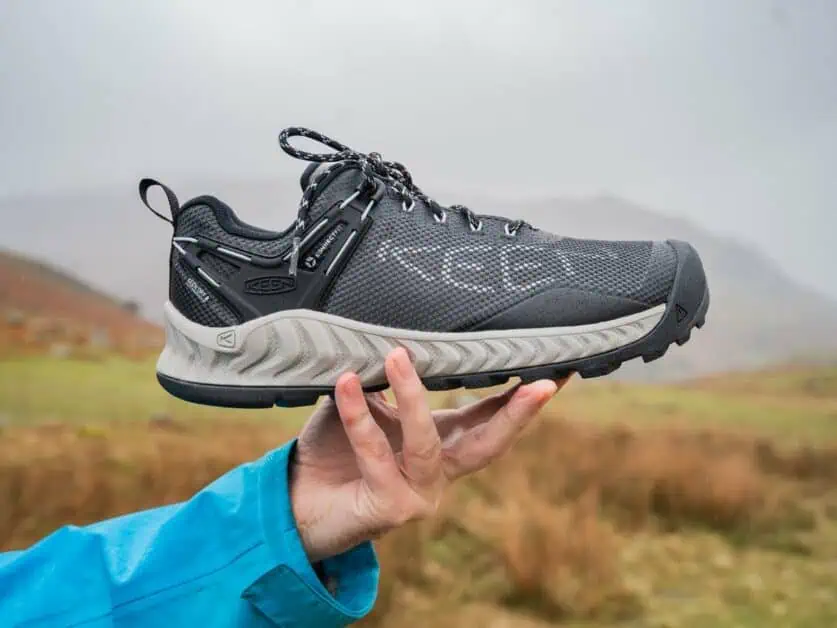
Approach Shoes
An approach shoe is often used by hikers who will be tackling steep rocks or intend to hike in to a climb. You’ll usually find approach shoes will be defined by their stronger toe cap and a heavier rubber slug around the foot. This is to help protect your feet from any serious knocks and bumps you might expect to encounter when tackling steep surfaces and protect from any slips as you move.
That said, they also have developed a following outside of these specific uses – they might not be the lightest, but they are often robust and durable, providing extra protection if you know you’ll be exploring a lot from undefined trails or in areas without heavy footfall. They’re also a great option if you know you aren’t the most foot savvy and want that extra level of confidence against toe injuries. The Black Diamond Mission Low is an excellent approach shoe for all round use, that are also waterproof.
Hiking Sandals
Hiking sandals have exploded in popularity in recent years – and they are a great option. Though we don’t think they should be your only pair of hiking shoes. Hiking sandals allow your feet and toes to breathe whilst offering a chunky sole that protects the base of the foot in the same way as a hiking shoe would. They’re great for camp in the evening, for wearing straight after a lake swim and are excellent for water crossings and desert terrain.
However, if you know you’re going to be doing anything like bush whacking or traveling through tall grasses or rough surfaces they might not be great for you. We particularly like the Terrex Hydroterra Sandals in this category – we’ve found them extremely well ventilated, quick drying and comfortable for longer journeys.
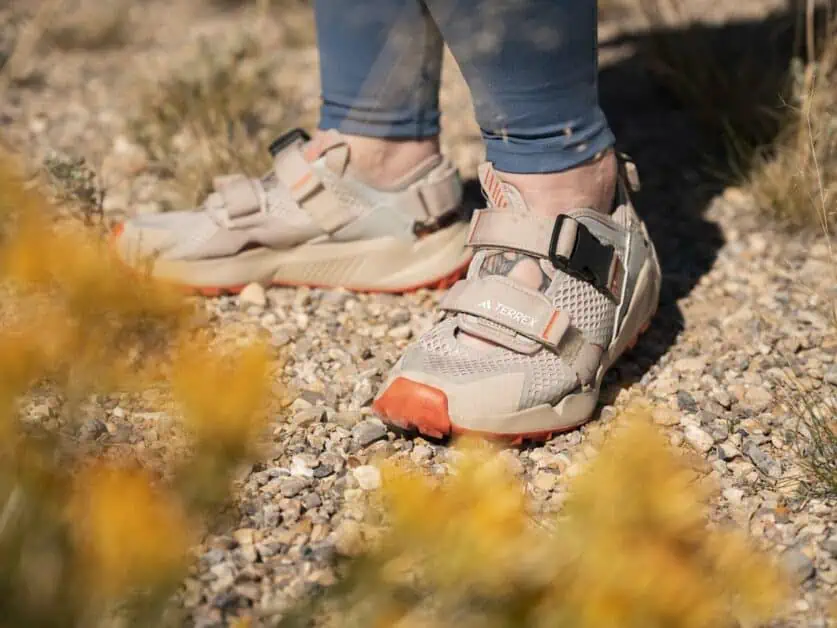
Hiking Boots
The old faithful hiking boot, still loved by many as the only option you’ll need outdoors and offered in a multitude of different fits, finishes and intentions, a bullet proof hiking boot will keep your feet protected. For general hiking, alpine trails, rough terrain, deep boggy locations and for keeping your feet warm whatever the conditions, hiking boots are still likely your best option.
That said, they can be overkill in some scenarios, and this is where hiking shoes come into their own. Firstly, since they offer a lot more in terms of protection, they can be a lot heavier than hiking shoes. This, over time, can lead to fatigue. But it’s also important to keep in mind that a hiking boot can be the best option for your knees and back when hiking with a heavier load.
They can also get quite hot in the summer, which, if not properly ventilated can lead to blisters from sweat. So, it’s worth looking at what you intend to do outdoors to make the best decision. Generally, we find we use hiking shoes more so in warmer months or warmer climates and hiking boots in the thick of winter when it is cold and wet, and we are likely to come across more boggy areas where hiking shoes might not stand up so well.
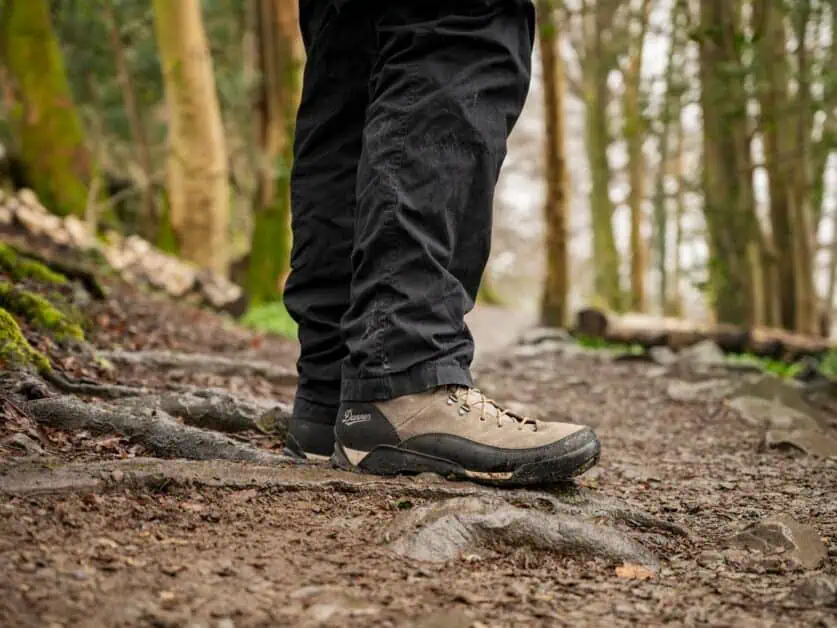
Which Walking Shoes are Best for Different Types of Hikes?
Whilst you might think that every hiking shoe can be used for all the different types of hiking you might expect to do, there are certain types of shoes that are better for different scenarios than others.
Long-Distance Trails
For longer distance trails, you want something you know can be really comfortable over a protracted period of time. Whilst a lot of people may suggest you opt for something that is fast and light here, we’d actually suggest going for a hiking shoe that is a good all-rounder. Something that is going to work just as well for rocky surfaces as it will for wetter conditions, as it will for forest, desert or anything in-between. The Danner Trail 2650 are one of our favorite picks in this category due to their versatility on the trail. We also love the Salomon X Ultra 4 GTX for their rigidity and streamline look and feel.
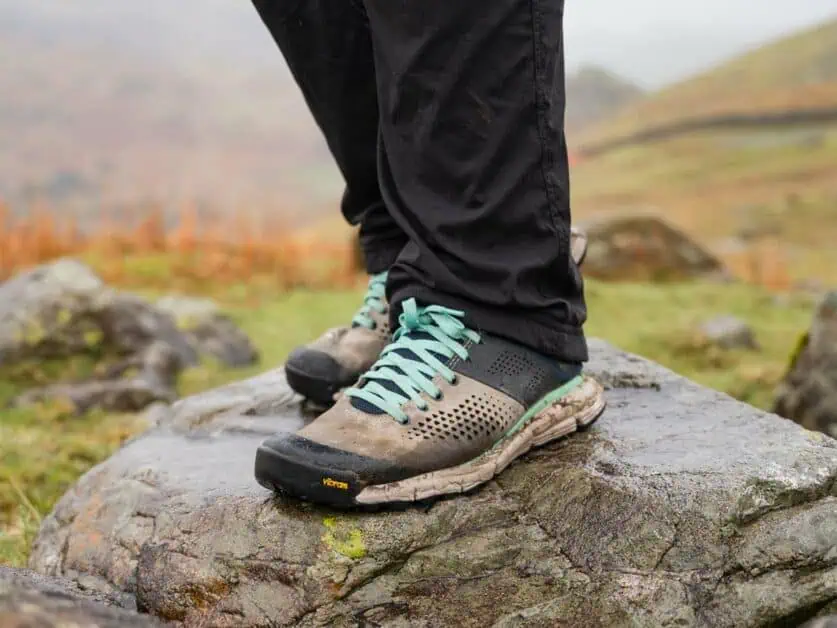
Backpacking
For backpacking, many hikers will favor a lightweight shoe – this can help minimize fatigue and improve comfort, which cannot be discounted when it comes to those longer distances! There are two main options in this area – one is to go for a shoe intended for trail running, this will prioritize fast and light. Whilst they are generally the most lightweight on the market, they do compromise a little on the traditional hiking ‘tread’ you will expect to see on the sole of the shoe. The other option is a more traditional hiking shoe that offers more support and can handle a greater load and may be more comfortable over difficult terrain.
Generally, though it is worth keeping in mind that hiking shoes and fastpacking shoes are designed more for light to medium loads when it comes to backpacking and they’ll work great on well-maintained surfaces and trails. If you intend to wear hiking shoes for backpacking, you’ll want to look for a pair that offers more cushioning in the midsole to help with shock and weight from a heavier pack. For most instances, you’ll want to consider more traditional hiking boots for much heavier packs to avoid any knee, back and hip problems.
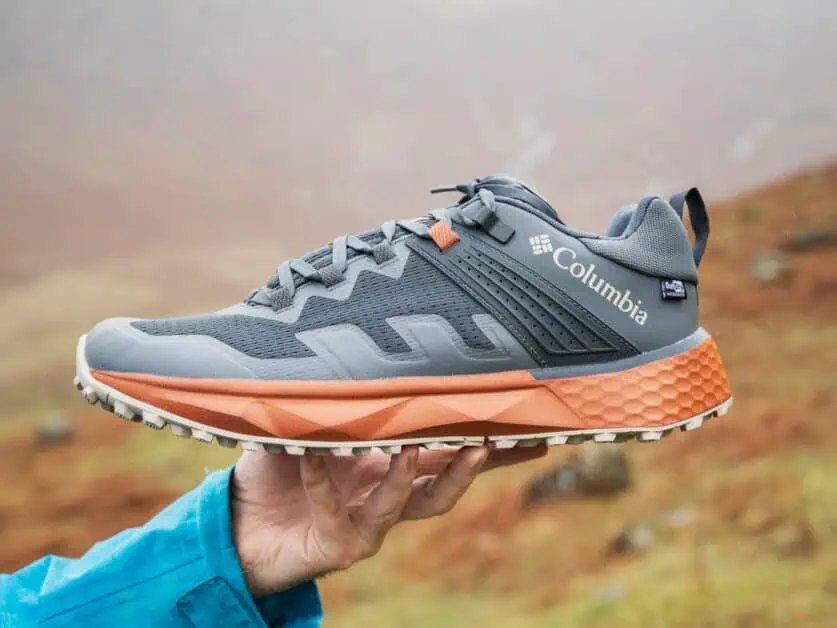
Day Hiking
With a hiking shoe that is best for day hiking, you can be a lot more flexible in what you choose. Since you generally won’t be hiking as far, or with as heavy a backpack, a shoe with good support around the toe and ankle is a good choice. You can opt for either a more traditional hiking shoe or something more like a trail running shoe. It’s wise to keep in mind where you’ll plan to hike – for example if you know it’s likely to be wet, you may be best looking for a waterproof hiking shoe.
City Walking
You may think you can easily transfer your hiking shoes to walking on pavement and in the city or more urbanized areas. That is true – hiking shoes can really be worn anywhere of course, but it’s important to remember that the soles of many hiking shoes are specifically designed to be worn on softer surfaces, with the grip and traction designed for this. This means that the soles are often made of softer rubber. Over time and if worn a lot on harder surfaces for long periods, your hiking shoes can wear out more quickly than if they were worn just on hiking trails. This doesn’t mean you shouldn’t wear them for this, it’s just something to keep in mind.
If most of your hiking will involve city walks, opting for a pair of trail runners may be the best option for you – these are a sort of hybrid running shoe or traditional sports shoe or trainer. They are more specifically designed to tackle a range of surfaces, and whilst they may not be perfect for difficult terrain in the outdoors, they can be perfect for compact, hard surfaces. We recommend the Altra Lone Peak 7 as one of the best options for urban and city walking.
Speed Hiking
Speed hiking, or fast packing as it’s also referred to means you’re moving as quickly as possible on the trail – think a hybrid between running and hiking. With this, your best shoe will be designed to move quickly, and you would be best suited to a shoe intended for trail running or similar. You want to prioritize lightness too – and some of the lighter shoes in our roundup (which you can use our comparison table to view side by side) would be well suited to speed hiking.
Trail Running
A trail running shoe is very much similar to the above (speed hiking) – it is more of a traditional trainer style that is intended to bounce fast and light from the ground with excellent shock absorption to help protect the knees and hips. We love the Merrell Moab Speed, which is an excellent combination of durability, comfort, weight and excellent composure on the trail.
Materials Used
Whichever hiking shoe you go for, there are a whole range of different materials used in their production to help you get the best experience whilst wearing them. They can be categorized in the following areas.
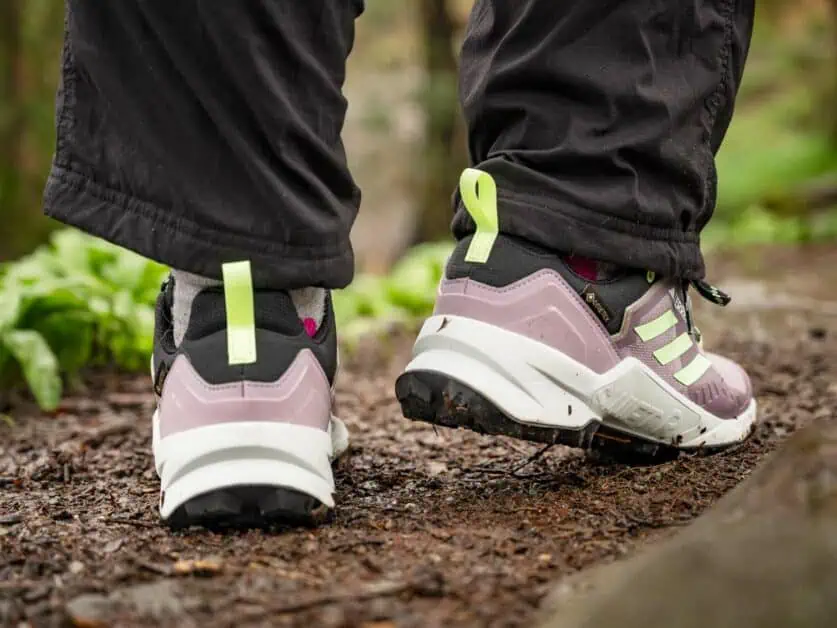
Fabrics
You can expect that most, if not all hiking shoes will make use of a number of different fabrics – this allows manufacturers to make the most of specific qualities to make the best shoe possible.
Nylon is used pretty frequently and is great for giving durability to the shoes as well as water resistance. Gore-Tex is often used in this context too, or the brands own in house design and technology as an alternative.
Mesh is also used fairly extensively and this helps with airflow – which keeps feet cooler when needed and can really help for avoiding painful blisters that can really impact your enjoyment of a hike.
You will also find that leather is still used fairly extensively when it comes to hiking shoes – it is still considered a premium material and becomes much more comfortable over time, making them last well.
Uppers
The upper of your hiking shoes is where you will most likely see leather or suede used, if they are on that model and this is generally to help with the shoe’s overall durability and the water resistance it can offer. Some also make use of synthetics here, especially more breathable models.
The materials used here are usually chosen to help withstand the pressure they are under when constantly hiking and also help to give extra comfort.
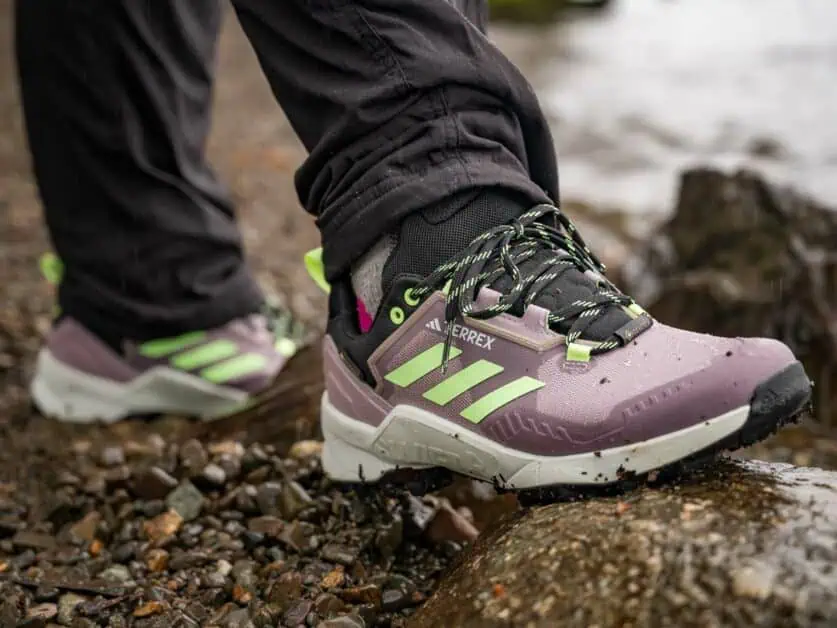
Insoles
Most hiking shoes come with a fairly standard insole – this should suit most hikers, but if you have any specific concerns about the insoles provided, it is very easy to change these out for a specific pair suited to your needs.
Certain brands, like Hoka do offer some of their hiking shoes with a fit tailored to certain concerns and are even approved by some doctors – so this may be worth bearing in mind if you have specific wants or needs from your insoles.
Soles
When it comes to the soles on your hiking shoes, there are a few options that are widely used and that you can look out for depending on the kind of terrain you’ll be experiencing and your personal preference. Vibram is a really popular name when it comes to hiking footwear. They are really well respected for the grip they give and they are really good at handling challenging terrain.
Another brand you will likely have heard of here are Continental. They make rubber soles that do really well in wet conditions, and make light work of slippery surfaces.
You will likely see EVA foam used in more fastpacking focused or ultra-lightweight shoes. This is great at giving flexibility and cushioning whilst also keeping the weight down. It’s also possible to get soles with a hybrid construction to get the best of both worlds.
Depending on where you hike, you’ll want to keep an eye on the kid of lug or tread pattern offered on the hiking shoe you go for. Naturally, deeper lugs are generally better for slippery or muddy surfaces.
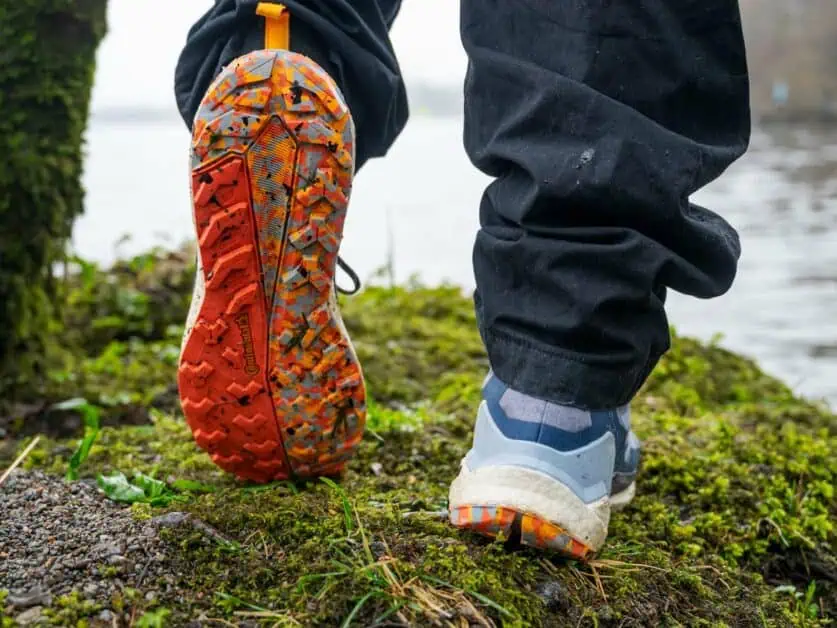
Breathability
Breathability is an important area to think about when buying your new pair of hiking shoes. This helps to stop any build up of moisture so you will feel more comfortable on the trail. Ultimately, hiking shoes that aren’t waterproof are always going to be more breathable than hiking shoes that are. Purely because they make use of mesh as opposed to ‘closed off’ materials.
You will want to think about the climate and places you’ll be hiking to make a decision here. For hotter locations a breathable pair will be better for you. Whereas if you’re hiking in wetter conditions, you will be better suited to a waterproof pair, even if they are less breathable.
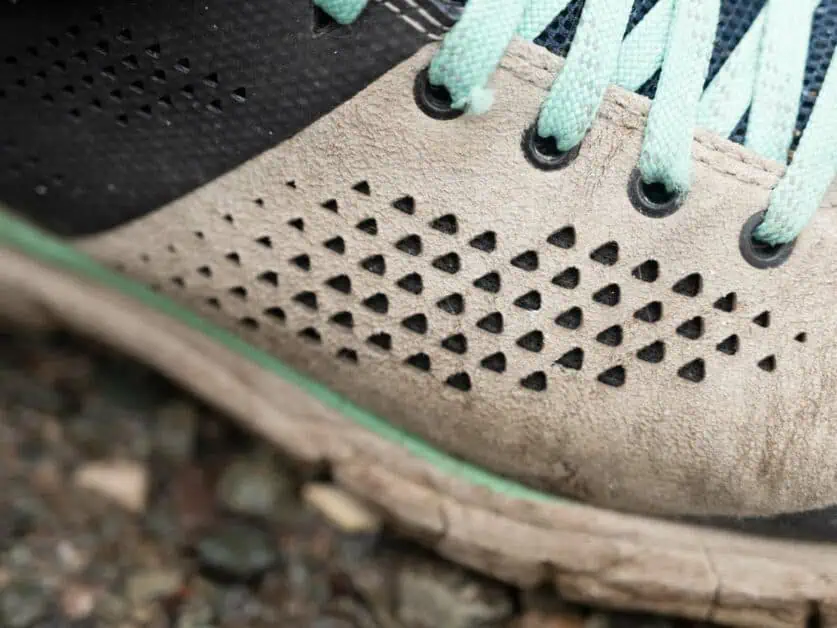
Durability
It’s important to remember that hiking shoes, like any shoes that are worn well, won’t last forever. That said, it’s important to look at a hiking shoe’s durability when buying. This is determined by the quality of the materials used and the construction. Don’t always be fooled into thinking the ultra-expensive pairs are the most durable – they aren’t always!
A sturdy outsole is also another important aspect of a good hiking shoe. You also want to look for a shoe that has a sturdy toe cap which is usually made of rubber.
The materials used can also help with longer term durability – materials like leather and suede generally stand the test of time, but do need more upkeep than a synthetic shoe.
Water Resistance
Most hiking shoes will give you some level of water resistance, but with some, they offer a fully waterproof option. Hiking shoes that are waterproof use a number of processes to get there, such as Gore-Tex, which gives the shoe a waterproof membrane. This essentially laminates the shoe’s inside and stops water from getting in whilst letting moisture out.
Some shoes instead just make use of a waterproof coating on the outer materials – this is generally referred to as durable water repellency (DWR). You may also find that certain seam sealing methods are used to help stop water from seeping in. Anywhere there is a seam is a potential area for water logging.
Sustainability
Sustainability is a hot topic in the outdoor world at the moment, and it is a banded around marketing term, but it is also forcing brands to become more ethical with their practices, manufacturing and in turn, products. You can expect to see the use of recycled materials more and more now in synthetic areas.
Plant based or more environmentally friendly products are also being used more commonly on previously harmful and microplastic heavy practices – such as DWR coatings.
BlueSign is also a good thing to look out for – these credentials are a good indication of how a brand fairs with its environmental standpoint.
Is There a Difference Between Men and Women’s Hiking Shoes?
Whilst we firmly believe that gendering in outdoors products is often outdated, there are some reasons why you will still see a men’s or a women’s fit in hiking shoes. This isn’t just because of what some people in a board room have dreamt up, and not just because they want to try and provide a pink option for women, these are usually made up of some generalizations about the differences in shape between men’s and women’s feet. It’s still a very binary way of thinking, and hopefully we will see some changes on this soon in the outdoors industry.
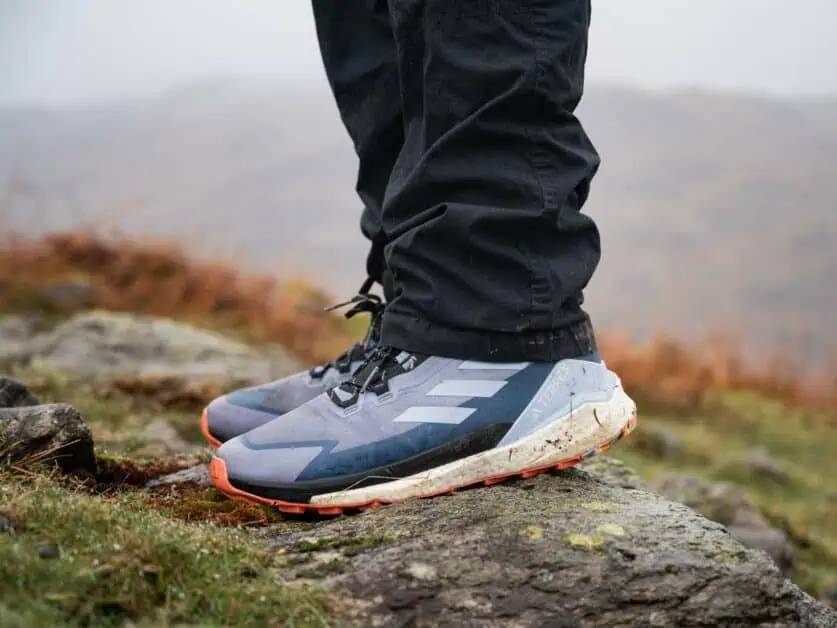
Whilst we don’t really like gendering in this sphere and believe that there should be a move to unisex where possible, we think it’s important to look at the information in a different way. Rather than viewing the options available as a ‘men’s’ and ‘women’s’ to look instead at them as ‘option one’, or ‘option two’, as essentially outdoor brands are providing two fit options to suit wearers.
There is no shame in deciding to buy one fit over another – it is more about what works for you best. Some people will fit the generalizations about certain genders better than others and some people will feel that one fit gives them more room than the other. We advise to look aside from the gendered names and get the fit that suits you best and works for your feet. Your comfort is the most important thing here.
You can use the information below on the differences between what you’ll usually see in a women’s versus men’s fit to help you decide which would be right for your next hiking shoe. That also means that even if we have selected a hiking shoe in our main guide to the best hiking shoes as a ‘men’s’ or ‘women’s’, you will be able to click through and find the alternate option to that one too.
Width
One of the key differences that you can often see very noticeably as soon as you take a men’s or women’s version of a hiking shoe and put them side by side is the width. With a women’s fit, you’ll see that most offer a wider toe section (or toe box) which tapers down to a narrower heel. A men’s shoe is usually much more uniform in its shape all the way down the shoe and wider than a women’s fit for the entirety of the shoe.
Weight
There can be a slight weight saving when it comes to the differences between a men’s and women’s hiking shoe. This is generally because a women’s variant will be offered with a slightly different mid sole. The generalization made by the outdoors industry is that women weigh less than men, so not as much support is needed in the mid sole. The lesser impact means that they can remove some cushioning, which does take down the weight. This may only be a small amount in terms of weight savings – we are only talking a few grams, but if every gram is important to you, this is something to keep in mind!
Support
Due to the differences in width distribution along a men’s versus a women’s hiking shoe, you will see some differences in support too. For example, if you have narrower ankles, but go for a men’s fit, you may find that your ankle moves around more and that your feet slip a little on your hike. Therefore, you may find a women’s fit better for you as it will ‘grip’ to your foot better. Likewise, with men’s shoes offering more in terms of arch support generally, you may also find that if you are heavier, that a men’s fit suits you.
Grip
You may find that because women’s fit hiking shoes are generally a little lighter than a men’s fit hiking shoe, that brands will add deeper lugs on the outsole. This will even out the grip differences you’d expect to see between a men’s and women’s fit shoe – with the assumption being that men are heavier than women. A men’s fit will generally have a smaller or shallower lug on the outsole than a women’s fit.
Appearance
If we put aside some of the absolutely comical color ways offered in women’s fit hiking shoes versus men’s, there are some differences to be aware off right off the mark. The main one is that you will notice a difference usually in the width – women’s have an almost shapelier feel, whereas a men’s fit has a more boxy, straight feel. You’ll see this in the toe box being wider and the heel or arch being narrower on a women’s fit.
Sizes
It is assumed that with a men’s fit, they will go up to larger sizes than a women’s fit. You can expect a women’s fit to typically stop at around roughly a 10 US/9 UK/45 EU. Whereas a men’s fit will go up to roughly 12/13 US/11/12 UK/50 EU. Though this does vary from brand to brand. If you have petite feet, you might find a women’s fit shoe will start at much smaller sizes than men’s fit – usually a 5 US/4 UK/35 EU.
Support
Support is really important when buying hiking shoes – after all they are what keep you going on the trail! The support you get from your hiking shoes will come from a few areas. Look for a sturdy and flexible sole – this will provide good arch support and cushioning as well as protection against shock from your movements. Reinforced toe caps and ankle support help to protect the foot from any injuries. The grip is also crucial when it comes to support – check for suitable lugs which will help on the slipperiest of surfaces.
Ankle Support
Whilst some models do offer a little more in terms of ankle support, there generally isn’t a lot in it from shoe to shoe, and most are low cut just below the ankle bone.
They are of course not going to protect you as well on more full on trails, but for well looked after trails and in good conditions, they should give you a perfectly good level of protection from injuries.
If you want to get the best of both worlds, we’d suggest looking at something more of a mid cut which can give you that bit more protection.
This should and will be completely personal based on the level of support you feel you need and also your confidence level.
Arch Support
Some hiking shoes will have a more shaped or molded footbed than others. Some will make more use of arch support inserts that work with your foot’s natural shape to give you better support where you might need it. Most shoes come with a standard arch support which will be perfect for most hikers, but if arch support is a primary concern for you, it is always best to look at the shape of the shoe more closely and look at the specific cushioning offered here.
Flexibility
Some hiking shoes are generally more rigid than others. Usually this will come from the materials used on the outer of the hiking shoe. For example, if the hiking shoe you’re looking to buy is fully waterproof, you can expect more robust materials to be used than those on a trail runner. Some hikers prefer more flexibility in their hiking shoe than others. Within our testing team, some prefer a more flexible sole and feel throughout the shoe to ‘feel’ their way around the trail. Others, who are maybe more prone to ‘trail clumsiness’ as they put it, prefer a more rigid shoe.
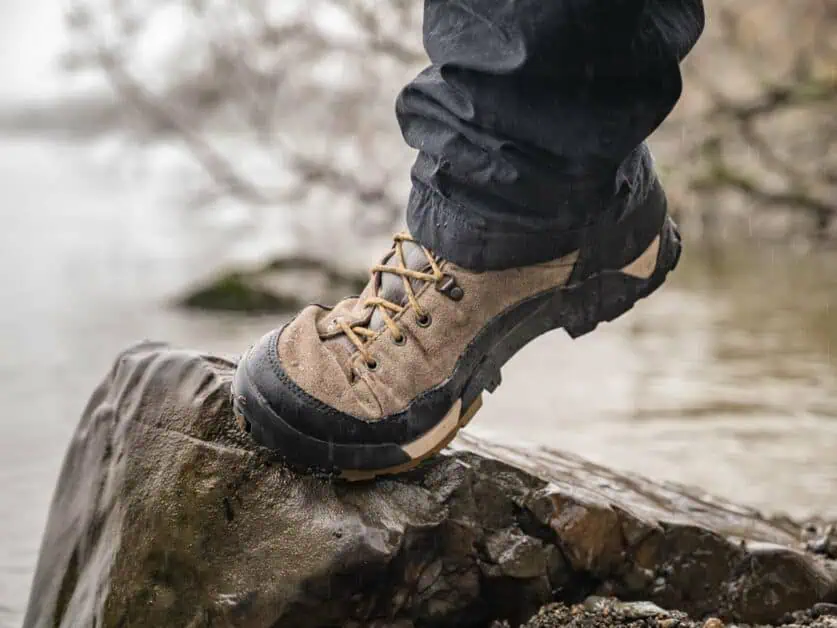
Stability
The hiking shoes that you decide to buy should protect your feet from all of the different terrains that you will be hiking in and should leave you feeling confident. Depending on where you hike, a firm and slightly flexible sole with a supportive mid and robust lacing system will be the best option.
If you do have any stability concerns, a slightly wider shoe can help as it gives you better contact with the ground and can help against any ankle rolls or twists.
Traction
The traction offered by a hiking shoe can make a difference depending on the kind of terrain you’ll be covering. If you know you’re going to be taking on challenging terrain, slippery surfaces, or tough rocks, then the traction offered needs to be important to you. If this is the case, look for deep, multi directional lugs on the outsole. These will help in a multitude of scenarios, including muddy, wet, rocky, and slippery surfaces. A sticky rubber compound on the sole is also helpful when it comes to slippery surfaces and will improve your confidence.
Comfort
We think comfort should be a top consideration when choosing your next pair of hiking shoes – we hope the reasons go without saying really, but overall comfort to us is more important than how ‘fast’ a shoe is, or how lightweight it is. The main areas to consider here are fit – if you have a wider foot, look out for our recommendations for wider fits. We also generally make note in our reviews of if a shoe is considered more suitable for a narrow foot or just normal. Some manufacturers are great at providing extra info on wide fit models, others aren’t. If you choose wrong here, you could be putting up with blisters and toe discomfort.
Choose based on where you plan to wear your shoes – if you hike in hot places with little chance of rain, opt for a pair which prioritizes breathability to keep your feet cool and dry. If you hike in rainier or wetter places, opt for a pair that offer waterproofing.
Lacing System
Lacing systems are more important than you might think for hiking shoes. You should consider the lacing system of the model you’re looking at and its compatibility with your foot shape. You should also pay attention to whether it will offer you enough support or adjustability. There is a lot you can do to improve your shoe fit to general foot concerns by lacing differently. You should check out our article on this to see how you can better improve the comfort of your hiking shoe lacing style.
There are a number of lacing styles that are used on hiking shoes and these allow you to get a really tailored fit to your foot. Quick lacing systems are becoming more popular – for example BOA systems give you a precise adjustment. They have also improved over time and are now as widely respected as traditional laces.
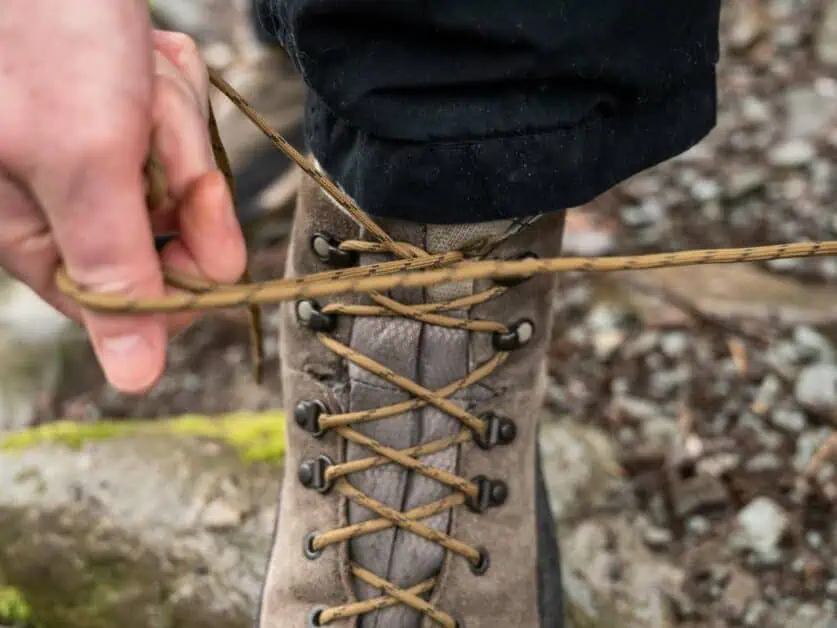
Toe Protection
Toe protection is an important consideration for hiking shoes – you are likely to come up against surfaces that could harm your feet if you stub into them and so reinforced toe caps that are made of synthetic materials like rubber are well used.
You should, as with many areas, consider the level of protection you need based on where you intend to hike and the potential hazards you’re likely to come up against. You should also make sure that when your shoes arrive, that the toe box provides a good level of roominess for toe splay – this will help massively with discomfort and prevent blisters or even worse, black toenails.
A snug fit around your toes is also important, as this will help to avoid any movement whilst hiking and maintain a snug fit.
Weight
The amount of weight that you have on your feet is really important when you’re hiking. Get it wrong and you can experience trail fatigue, and this can really impact your energy over a longer period and make your time outdoors less fun.
Going for a lighter shoe will help reduce fatigue on longer trails, but it does have a positive impact on day hiking too. A lighter hiking shoe can sometimes be less durable than a heavier hiking shoe though. Generally, a heavier shoe makes use of more durable or tougher materials which are naturally heavier.
How to Use and Care for Your Trekking Shoes
If you take care of your shoes, you can expect them to last a really long time, and this is an important step in keeping them looking and feeling good for a long time.
Keeping your shoes as clean as possible is a good first step, and you can use something like a gentle brush with a very mild detergent to get rid of any dirt. This will help keep the waterproofing working as it should do and will also stop materials like leather or suede from deteriorating.
You should also look to use a waterproofing treatment spray for shoes every few months, this will help keep them doing their job for longer.
When it comes to storage, keep them somewhere cool and dry to stop any nasty smells or mold and mildew.
Break-in Period
No hiking shoe is good to wear straight out of the box, even though it might feel like it is. It is important, even if your new hiking shoes feel comfortable straight away, to take them for a few test walks. This can be locally, and you can build up very gradually. You should just know when you feel confident enough to take them out on longer trails. There should be no parts that pinch or rub by this point.
Some shoes do have a longer break in period than others – generally those made of leather can take a little longer to wear in, but the break in period should not deter you from buying a pair of hiking shoes – and many times, the ones that take a while to bed in can be the most comfortable ones.
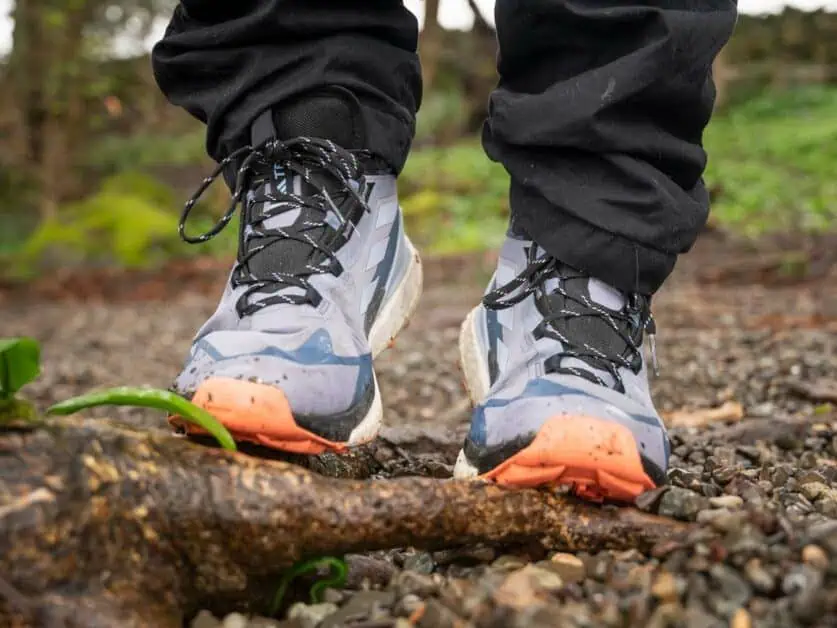
Cleaning
To clean and care for your hiking shoes well, you should remove any dirt or debris from them before anything further – you can do this with a soft brush, or you may find a damp cloth also does well here too.
You can either make use of a shoe cleaner or a mild detergent to get rid of any stains – you can also use something called a spot treatment for more stubborn stains. Once washed, allow your hiking shoes to air dry – this is the best way to keep them looking and feeling their best for wear. You should try and avoid drying your hiking shoes in a washing machine as this can encourage shrinkage and a change in the fabric dynamics.
Weatherproofing
Many waterproof hiking shoes will not stay as waterproof forever as you might want them to. This is nothing to do with how well designed the hiking shoe is, and more likely that the waterproof treatment (DWR) isn’t working so well and needs a reapplication treatment. The reason they may not feel so waterproof anymore is usually more to do with sweat wicking than anything else, as if the waterproof membrane is not working correctly, and not allowing for sufficient transfer, you may notice lesser latency to water. This can be rectified by using a waterproofing treatment on your hiking shoes regularly.
Maintenance
Maintaining your hiking shoes really just involves taking into consideration the points listed above – keeping them free from dirt and debris as much as possible, keeping them clean and making sure any DWR coatings are looked after.
Another way you can really increase the longevity of your hiking shoes is to make sure you untie them and retie then between putting them on and taking them off. It may seem like the easiest option to slip them off, but this can really damage the heal of the foot and shorten their lifespan.
Storage
To keep your hiking shoes looking and feeling their best for as long as possible, keep them in a dry location – this will help to avoid any mold or mildew build up. With that in mind, it is always best to store them indoors – a garage is a only a good idea if it is dry and free from damp.
Conclusion
There is a lot to consider when buying a pair of hiking shoes – and with there being so many options on the market now, it can feel pretty overwhelming to choose. Really, it’s about looking at your intended use and where you plan to go hiking that are the biggest deciding factors for your purchase. You should also be looking at if you have any previous injury concerns and how a particular design might affect comfort as well.
We hope this guide has made it easier to get a handle on what you need to consider when buying your next pair of hiking shoes – with the right pair, you’ll enjoy the trails comfortably, so you can focus on what you enjoy more!
Disclaimer: This article contains Affiliate Links. You won’t pay any more for buying through these links, but we may receive a commission from any purchases made through them. As an Amazon Associate, I earn from qualifying purchases. If you choose to support us by buying through our links, we thank you as it helps us to continue providing the resources we do to help you enjoy the outdoors more!
